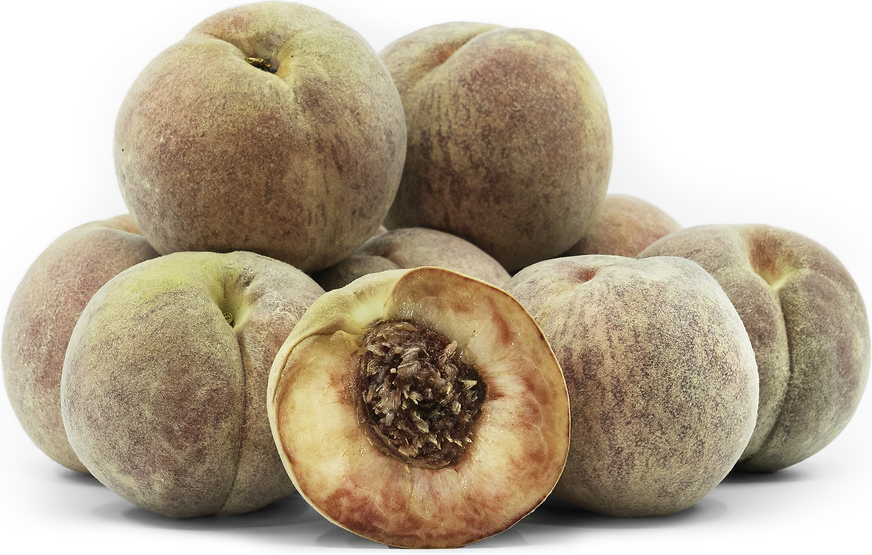


Blood Peaches
Estimated Inventory, 10 lbs : 0
Description/Taste
Blood peaches are large fruits, averaging 15 to 25 centimeters in diameter, and have an oblong to slightly flattened, round shape. The skin is firm and golden yellow with patches of red blush, covered in faint, mottled crimson striping and spots. There is also a soft and velvety coating of fuzz, giving the fruit a silvery, pale grey appearance. Underneath the surface, the flesh is dense, crisp, and aqueous, encasing a fibrous pit that is embedded tightly in the flesh. The signature bi-colored, red and yellow flesh can be filled with dark red streaks or entirely stained red-purple, depending on the fruit’s growing environment and time of harvest. Blood peaches are aromatic and have a tender, semi-soft, and crunchy consistency. When ripe, the flesh has an initially sweet, floral, and berry-like flavor, followed by a pleasantly tart, tannic aftertaste.
Seasons/Availability
Blood peaches are available for a short season in the late summer.
Current Facts
Blood peaches, botanically classified as Prunus persica, are rare, heirloom fruits belonging to the Rosaceae family. The late-season peaches are considered a clingstone variety, meaning its flesh adheres tightly to the fruit’s pit, and are known as an “old world” fruit in reference to its ancient origins. There are multiple varieties of Blood peaches cultivated around the world, sharing similar characteristics in appearance and flavor, and the multi-colored fruits are also known as Cherokee peaches, Indian Blood peaches, and Blood Cling peaches. Blood peaches are not commercially cultivated and are only available for a few weeks in the late summer. The variety is becoming increasingly difficult to find, but in the past decade, specialty growers have begun cultivating heirloom varieties such as Blood peaches to protect diversity within the market. Blood peaches are favored by peach enthusiasts and chefs for their multi-colored flesh, firm texture, and sweet-tart flavor, primarily used fresh to visually enhance dishes or canned for extended use.
Nutritional Value
Blood peaches are a good source of potassium, a nutrient to help regulate fluid levels within the body and are an excellent source of vitamins A and C, which are antioxidants that strengthen the immune system. The peaches also contain fiber to stimulate digestion and provide some iron and calcium.
Applications
Blood peaches are favored for fresh applications to showcase their unique colored flesh. The peaches can be sliced and tossed into fruit bowls and green salads, quartered and displayed on cheese plates, or used as a topping over ice cream, tarts, and cakes. The firm-fleshed fruits are also suitable for cooked applications, including baking, canning, and pickling. When cooked, the peaches can be simmered to create jellies, jams, and sauces. In mixology, Blood peaches are sliced and used as a garnish and are blended with other juices to flavor cocktails. Blood peaches pair well with other stone fruits, honey, custard, lavender, citrus, cardamom, basil, arugula, nuts, and soft cheeses. Despite the fruit’s dense and firm consistency, Blood peaches are highly perishable and can only be stored in the refrigerator for 1-3 days.
Ethnic/Cultural Info
Blood peaches, known as Peche Sanguine and Peche de Vigne in France, were once used in the Coteaux du Lyonnais winemaking region to protect grapevines. Young peach trees were planted at the end and in the middle of each row of old vines, as they were more susceptible to funguses and diseases such as downy mildew. Each day, the winemakers would check the peach trees for signs of decay, and if the trees exhibited damage, the grapevines would be immediately assessed and treated, saving whole crops of grapes and wine from destruction. As the tradition of planting peach trees in vineyards continued, winemakers would select the best peaches of each season and use those seeds for next year’s planting, developing stronger and highly productive trees. Legend has it that over time as the peach trees grew stronger, they began to produce more antioxidants, giving the flesh its dark red streaks and hue.
Geography/History
Blood peaches are believed to be native to Southeastern Asia and were cultivated in China before the 11th century. The fruits were then spread to Europe, where they have been cultivated for hundreds of years, and were also brought to North America sometime before the 16th century, either through early Asian settlers or through Spanish explorers. Unlike most stone fruit, which is grafted from budwood, Blood peaches grow easily from seed, making it ideal for transport and sharing. In the 17th century, European explorers arrived in the New World and discovered Blood peach trees already growing in the Southeastern United States by the Cherokee nation. Blood peaches continued to increase in popularity as a canning variety and became especially famous when they were selected as one of thirty-eight varieties in Thomas Jefferson's south orchard at Monticello, where they are still grown in the modern-day. Today Blood peaches can occasionally be found growing in the wild of the Southeastern United States and are cultivated on a small scale through select growers. The fruits can also be spotted for just a few weeks at late-summer farmer's markets, specialty grocers, or in home gardens.
Recipe Ideas
Recipes that include Blood Peaches. One
| With A Glass |
|
Upsidedown Vineyard Peach Tart |

















